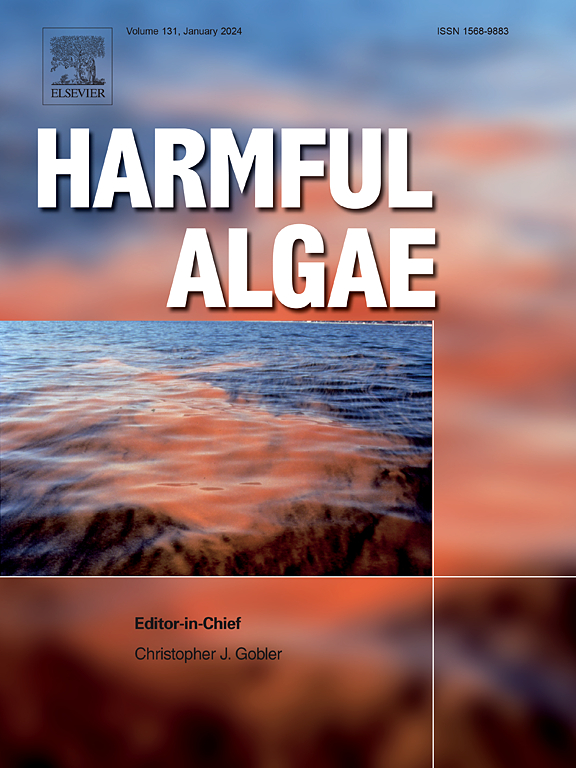中国沿海地区青虾原群产毒多样性研究
IF 4.5
1区 生物学
Q1 MARINE & FRESHWATER BIOLOGY
引用次数: 0
摘要
利马原藻(proorocentrum lima, P. lima)分布于中国四大海域。现有的研究证实了利马的多样性分布。这种多样性特征对腹泻性贝类毒素(DSTs)成分差异的影响需要立即调查。本研究从中国4个主要海域分离得到10株利马藻,探讨其生长、毒性产生和酯化成分的地理差异。培养21 d后,来自渤海和黄海的菌株(SHG和QD)生长缓慢,最大细胞密度为3.3 × 104个细胞·mL-1,而来自南海的菌株(WZD和3XS)生长速度最快,最大藻密度为9.4 × 104个细胞·mL-1。单细胞总毒素含量为4.8 ~ 10.1 pg·细胞- 1,其中SHG和QD的总毒素含量最高,为10.1 pg·细胞- 1。10个菌株共鉴定出24种酯化成分,占总毒素的43.9% ~ 92.2%,其中以SHG和QD菌株含量最高。产自中国4个主要海域的利马鱼的生长、毒性和酯化反应均有显著差异。生长和毒性潜能的对比揭示了青豆在不同地理环境下的适应机制的存在,毒素在适应机制中的作用有待进一步探索。本文章由计算机程序翻译,如有差异,请以英文原文为准。

The toxin-producing diversity of Prorocentrum lima (Dinophyceae) populations of coastal China
Prorocentrum lima (P. lima) is distributed in the four major seas of China. The diversity distribution of P. lima is confirmed by existing studies. The impact of this diversity feature on the difference of diarrhetic shellfish toxins (DSTs) components requires immediate investigation. Ten strains of P. lima were isolated from four major seas of China to explore the geographical differences in growth, toxicity production, and esterified composition. After 21 days of cultivation, strains isolated from the Bohai and Yellow China Sea (SHG and QD) exhibited slow growth and a maximum cell density of 3.3 × 104 cells·mL–1, whereas strains from the South China Sea (WZD and 3XS) demonstrated the highest growth rate and maximum algal density of 9.4 × 104 cells·mL–1. The total toxin content in single cells varied from 4.8 to 10.1 pg·cell–1, with SHG and QD displaying the highest total toxin content at 10.1 pg·cell–1. A total of 24 kinds of esterified components were identified across all ten strains of P. lima, comprising 43.9 %–92.2 % of total toxins, with the highest levels found in SHG and QD strains. Growth, toxicity production, and esterification of P. lima, taken from the four major sea areas of China, were significantly different. The contrasts in growth and toxicity potential revealed the existence of adaptive mechanisms of P. lima in different geographic environments, and the role of toxins in the adaptation mechanism requires further exploration.
求助全文
通过发布文献求助,成功后即可免费获取论文全文。
去求助
来源期刊

Harmful Algae
生物-海洋与淡水生物学
CiteScore
12.50
自引率
15.20%
发文量
122
审稿时长
7.5 months
期刊介绍:
This journal provides a forum to promote knowledge of harmful microalgae and macroalgae, including cyanobacteria, as well as monitoring, management and control of these organisms.
 求助内容:
求助内容: 应助结果提醒方式:
应助结果提醒方式:


